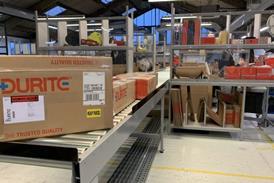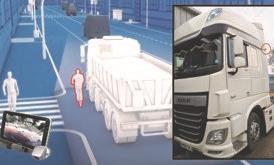Sainsbury’s is Britain’s third largest grocery retailer (behind Tesco and Asda), turning over nearly £23bn in the year to 19 March 2011 and making a pre-tax profit of £827mn.
Despite buying 24 stores from the Co-op in 2009 in the north and Midlands, Sainsbury’s stronghold remains the south east of England, and if it is to challenge for top slot and fend off the threat of fourth placed supermarket Morrisons, it has to expand its footprint outside this most affluent part of the country.
Sainsbury’s logistics director, Dave King, came from Morrisons, the Yorkshire-based grocer that swallowed rival Safeway in 2004. As well as instantly expanding Morrisons’ coverage of the UK outside its northern heartland, it created a group to challenge Sainsbury’s third position, making a pre-tax profit of £874m on turnover of £16.5bn in the year to January 2011.
“Our market share is strongest in the South East,” says King. “So we have a huge opportunity to expand in the north and west.”
In the last two years, Sainsbury’s has opened 59 new supermarkets, 37 extensions and 98 convenience stores. Of these, 31 have been in the north of England.
Sainsbury’s 1,000 stores (its 1,000th store opened in November 2011 in Irvine, to the west of Kilmarnock in North Ayrshire on the south west cost of Scotland) are served by 22 DCs, of which 12 are multi-temperature composite RDCs, five specialist DCs handling slower moving non-food ranges and two frozen food depots. The group has developed retail formats ranging from small convenience stores to very large superstores (of which it operates four).
“We have a healthy pipeline of stores under development,” says King. “These include both convenience stores and supermarkets.”
According to Roger Burnley, Sainsbury’s retail and logistics director, within its current five year planning horizon, Sainsbury’s will open three more DCs – two more composite sites and one specialist non-food centre. He says that with 59 stores Scotland is pretty well covered and the store development programme will focus in the north east and south west of England.
Sainsbury’s will stick with its policy of using a “healthy mix” – currently around 50/50 - of inhouse and third party management for its DCs, though it will continue to use third parties for specialist non-food lines – DHL handles all its clothing distribution, for example.
“We don’t differentiate between third party and Sainsbury’s managed depots,” says Burnley. “They keep us competitive and allow us to benchmark ourselves.” King adds: “We see it as a partnership – and I hope they would tell you the same.”
The decision on when to add an extra DC to the network as new stores open is a difficult one, as leaving it too late will put too much pressure on the existing depots but adding capacity too early increases cost. “We have stretched depots to cope with expansion of the store portfolio, and there is a minimum number of new stores we have to open before we put on a new depot,” says King.
The grocery distribution network currently handles 23 million cases each week in 25,000 deliveries made by a fleet of 1,340 trucks and 2,300 trailers, the majority of which are temperature controlled. Sainsbury’s is planning to run seven 14.6m and three 15.65m trailers in the DfT trial of longer vehicles. “We will look at using them on both ambient and chilled products as we don’t weigh out on either,” says King. “Double deck trailers can be hard to get into some stores though we are trialling a scissor lift to unload fixed-deck double decks at stores a long distance from the DCs.”
Because all stores now trade seven days a week, Sainsbury’s DC staff work the same five from seven day rota like their in-store colleagues.
“In some stores, Sunday is the busiest six hour period of the week,” says King. “All stores get deliveries seven days a week and we give a round the clock service where we can. We would like to do more at night but many stores have curfews so we can’t deliver overnight.”
Sainsbury’s store in the south London borough of Wandsworth took part in the DfT’s quiet delivery demonstration scheme, and the company is working to make its night time deliveries quieter – including using roll cages with rubber hinges and wheels to cut down on the traditional rattle when they moved around.
King is sanguine about possible disruption due to the Olympics, partly because he has a dedicated team working on a plan to work around the restrictions on the Olympic route network. “We will cope,” he says.
He sees the Olympics as a good opportunity for the transport sector to show it can deliver quietly at night, but is concerned that some may take advantage of any emergency relaxation of restrictions on night time operations: “It would be a shame if people abuse the Olympics.”
Sainsbury’s led the supermarket pack in developing its Sainsbury’s Integrated Transport Management System that integrates Paragon routeing software with Isotrak vehicle tracking to plan and monitor store delivery schedules. More recently it has added a Warehouse Management System based on software from US firm RedPrairie, and has rolled out handheld devices enabling staff to track every product in all 22 DCs.
King says the next step is likely to be increased warehouse automation and new methods of product handling, though the company will be wary of repeating the mistakes of a decade or so ago when over-complex and unreliable automated systems regularly failed, leaving stores out of stock and losing sales.
Safety in the DCs is a primary concern, and Sainsbury’s has developed a beautifully simple idea to prevent trailers being pulled off docking bays while they are still being loaded or unloaded. As well as the usual traffic lights warning drivers not to move a trailer, a padlock is fitted to the trailer air line connector to prevent them being coupled to the unit. The key to the padlock is hung on the dock roller door handle so it cannot be retrieved and the suzies connected until the door is closed and the trailer is safe to move.
‘Twas the season to be busy – Waltham Point stats
The meeting with King and Burnley took place at Sainsbury’s 700,00sq ft Waltham Point chilled and ambient composite DC just off junction 26 of the M25 in Essex during an open day for press held in the run up to Christmas.
Waltham Point opened in 2003 and at 700,000sq ft is Sainsbury’s biggest DC. It employs over 1,200 people.
The DC’s fleet of 88 units, 220 trailers and 22 rigids makes over 1,800 deliveries a week to 83 stores in London, Essex and Hertfordshire as well bringing products from 89 primary collection points. The site includes a returns and recycling unit that processes crates and packaging returned from stores so no waste is sent to landfill.
Its average throughput of 300,000 cases a day rises to 428,000 a day in the week before Christmas. Waltham Point uses parcels-style belt sorter, with incoming pallets being stripped and cases placed on the sorter. 3D barcode readers scan every item, and they are directed to one of 180 outgoing chutes where roll pallets or cages are assembled for loading onto the store delivery vehicle. The sorter can handle up to 22,000 cases an hour.
Nationally, Sainsbury’s delivered 30 million cases to its 1,000 stores in the seven days before Christmas, up from the normal average of 23 million cases a week.
“We plan Christmas all year,” says Burnley. “We start in January, learning the lessons from the one just gone.”
After its experiences of the severe winter of 2010/11, Sainsbury’s developed a plan to supply stores from other DCs if one hub is hit by snow and King sees no need to fit winter tyres to any Sainsbury’s vehicles.
“We were really pleased at how we did last winter,” says King. “That is down to the fact we manage our primary distribution ourselves. It gives us the flexibility to maintain product availability.”
According to Burnley, the distribution network carries around 10% surplus capacity to provide this flexibility, a cost burden the firm believes is worth bearing to ensure there are no repeats of the drop in product availability Sainsbury’s suffered around 2004.
It also hires in extra fleet to cope with the Christmas peak, though King admitted that the defleeting by the major trailer rental firms since 2008 meant trailer availability was tighter in 2011/12. A bigger problem however has been the rising cost of fuel – “that is a pressure point for all of us,” he says.
Sainsbury’s stockpiled 12,000 tonnes of salt for this winter, with its three main regional DCs – Waltham Point, Dartford in Kent and Langlands Park in East Kilbride, Scotland - each holding 66 tonnes.
Each of these DCs also has a new specially built distribution truck that can be fitted with a snowplough and grit spreader to keep the centres and access roads free in case of snow. The two 26 tonne Volvo and one 18 tonne Mercedes-Benz rigids – dubbed ‘transformers’ by staff – use Econ bodies with a Weightlifter demountable system to quickly convert between refrigerated delivery and snowplough modes.
The gritters are loaded with bagged salt by a counterweighted FLT and can spread 2 tonnes of salt a day. Sainsbury’s has previously fitted snow ploughs to tugs at its DCs, using a weight on the fifth wheel to help with grip, but this is the time it has fitted a plough to a dedicated gritter lorry.
While the build up to Christmas is the busiest time of the year, Christmas Day is one of only two days in the year – Easter Sunday being the other – when the distribution network shuts down completely. As a result, these have the peak days for the maintenance and IT departments to do essential work that requires a 24 hour shutdown.



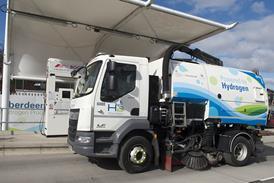


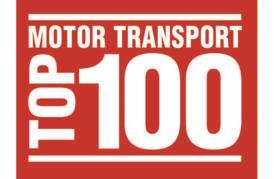
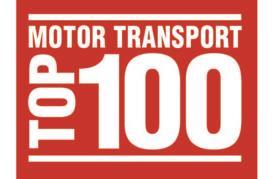
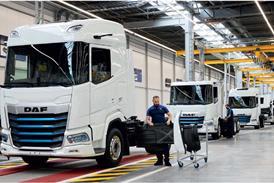
![Mercedes-Benz_eActros_600_(1)[1]](jpg/17820_mercedesbenz_eactros_600_11_978080.jpg)

